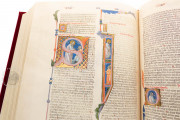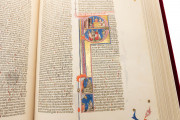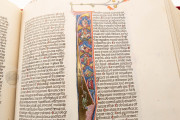The so-called Bible of Pietro Cavallini is a large and sumptuously illuminated Christian Bible created around 1300 in Rome or Naples. Its illumination reveals the profound influence of the style of the Roman master Pietro Cavallini, and it has been proposed that he was personally involved. It was probably made for Landolfo Brancaccio. It boasts 131 historiated initials of consistently high artistic quality, many of which have foliate extensions populated by little animal and human figures.
The Bible includes many prologues to the individual biblical books and the explanation of the meanings of Hebrew names by Stephen Langton (d. 1228). Typically, the prologue texts are introduced by a decorated initial of foliate and geometric motifs or a historiated initial with a portrait. Historiated initials with narrative scenes usually mark the beginnings of the biblical books proper.
Monumental Openings
The two grandest initials in the Bible mark the beginnings of the Old and New Testaments: the initials I and L that open Genesis and the Gospel of Matthew. The Genesis initial extends the height of the text area and angles across both columns at the bottom of the page (fol. 4r). The six days of Creation; the Creation of Eve; the temptation, expulsion, and labors of Adam and Eve; and the Crucifixion are pictured in fourteen roundels, with the Fall of Humanity at the angle in the lower left corner.
The Gospel of Matthew is introduced by the Tree of Jesse, a visualization of the genealogy of Christ from Jesse through King David and the Virgin Mary (fol. 322v). Jesse leans his head heavily on his right hand; his outer garment is a shimmering rose color with golden highlights that reveal his recumbent body beneath.
Unfolding Narratives
Although the backgrounds to the scenes are schematic, either geometric diaper patterns or blue with thin, white curling decorative motifs, the figures seem to have volume and weight, a hallmark of Cavallini's pioneering approach to the human figure rendered in paint. The handsome faces also recall the work of Cavallini.
Some of the initials display narrative richness. In the initial I for the book of Ruth, for example, her story unfolds in six scenes (fol. 85r). And, in the opening letter of the Gospel of Mark, not only is the evangelist shown writing his text, but also John the Baptist is depicted twice, baptizing the people and then Christ (fol. 333r).
The Scribe in Paradise
The text is written in a neat Gothic Rotunda script by a single scribe, who asks that he may live in Paradise (fol. 438r). The text is in two columns, except for the explanation of Hebrew names, which is in three columns. Another scribe provided textual variants in the margins.
A remarkable feature of the book is the pen-flourished initials. The flourishing often extends the entire height of the text in the left margin or the intercolumnation and into the upper and lower margins (fols. 1-110). The pages of the explanation of Hebrew names are a decorative tour-de-force, with pen-flourished initials of alternating color schemes occurring frequently in all three columns (fols. 407-429).
Personalized for Its Patron
The manuscript's patron is pictured in a purple robe kneeling under the image of the Crucifixion of the Genesis initial (fol. 4r). The book was undoubtedly made for a member of the Brancaccio family, as evidenced by the presence of the family coat of arms (fol. 322v). The most likely patron is Landolfo (d. 1312), a Catholic cardinal of a powerful Neapolitan family.
The manuscript was acquired in the mid-eighteenth century for the Benedictine monastery of San Nicolò l'Arena in Catania, on the east coast of Sicily. The current binding of leather over pasteboard dates from the early nineteenth century.
We have 1 facsimile edition of the manuscript "Bible of Pietro Cavallini": Grande Bibbia di Pietro Cavallini facsimile edition, published by Istituto dell'Enciclopedia Italiana - Treccani, 2018
Request Info / Price


































